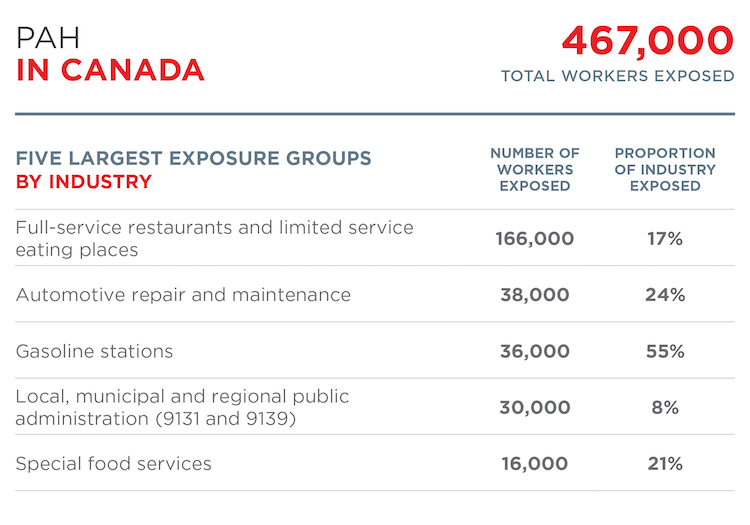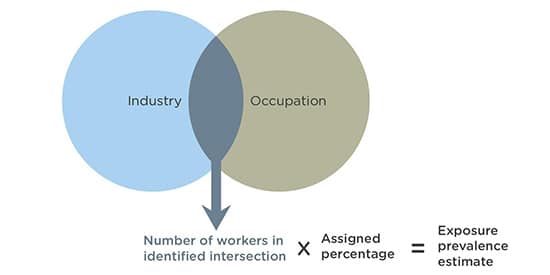PAHs Occupational Exposures
PAHs Occupational Exposures
Overview
Inhalation and dermal exposure are the main routes of exposure to PAHs in occupational settings.[1]
CAREX Canada estimates that approximately 467,000 Canadians are exposed to PAHs in their workplaces. The largest industrial groups exposed are restaurants, automotive repair and maintenance, and gasoline stations.
READ MORE...
The largest occupational groups exposed to PAHs are cooks, where PAHs are released in the kitchen while food is being cooked. Other food establishment workers may also be exposed, including chefs. Automative service technicians and mechanics and firefighters may be exposed as well, along with workers in coal tar production and distillation, coal gasification, coke production, paving and roofing using coal tar, creosote wood preservation, aluminum production, carbon electrode manufacture, mining, metalworking, calcium carbide production, municipal trash incinerators, petroleum industries, chemical production and transportation, electrical industries, and chimney sweeping.[1,2]
In some industries, such as aluminum production, benzo[a]pyrene levels can reach up to 100 µg/m3, which is more than 10,000 times higher than typical ambient air concentrations.[2]
According to the Burden of Occupational Cancer in Canada project, occupational exposure to PAHs leads to approximately 130 lung cancers, 50 skin cancers, and possibly 80 suspected bladder cancers each year in Canada, based on past exposures (1961-2001).[3,4] This amounts to 0.6% of all lung cancers, 0.1% of all skin cancers, and 1% of all bladder cancers diagnosed annually. Most PAH-related cancers occur among workers in the manufacturing and construction sectors. Work-related PAH exposure resulted in approximately $183 million in costs for newly diagnosed lung, non-melanoma skin, and suspected bladder cancer cases in 2011.[4]
Prevalence Estimate
Results show that approximately 467,000 Canadians (approximately 2.6% of the working population) are occupationally exposed to polycyclic aromatic hydrocarbons (PAHs); 75% of these workers are male. Industries with the greatest numbers of exposed workers are restaurants, automotive repair and maintenance, gasoline stations, and public administration (including firefighters).
The largest occupational groups exposed to PAHs are cooks (183,000 workers exposed), where PAHs are released in the kitchen while food is being cooked. Other food establishment workers may also be exposed, including chefs (50,000 workers exposed). Other important occupations that may be exposed include automative service technicians and mechanics (78,000 workers exposed) and firefighters (33,000 workers exposed).
The number of workers exposed to PAHs increased by approximately 117,000 workers from 2006 to 2016 (a 33% increase). This was driven by an increase in the total number of workers in food services and drinking establishments.
Workers exposed to PAHs by industry in 2016

Workers exposed to PAHs by region in 2016
Click the second tab to view total number of workers exposed.
* = < 50 workers
Methods and Data
Our Occupational Approach page outlines the general approach used to calculate prevalence and exposure level estimates for workplace exposures.
Data Sources
Data used in developing the occupational estimates for polycyclic aromatic hydrocarbons (PAHs) were collected from several sources:
- The Canadian Workplace Exposure Database (CWED) contains approximately 4,200 measurements for PAHs exposure. These measurements were collected during the years 1981 to 2004 in Ontario and British Columbia workplaces.
- Canadian and US scientific peer reviewed publications that addressed PAH exposure in Canada and the United States.
- Grey literature including technical reports from governments and international bodies.
Prevalence Estimate Method
CAREX defines exposure to PAHs as inhalation exposure at work above levels expected to be encountered by the general population. It does not include exposure to specific petroleum-based products or combustion by-products (such as bitumens, coal tars and coal tar pitches, diesel engine exhaust and creosotes, as there are separate CAREX estimates available for these substances).
To determine the number of workers potentially exposed to PAHs at work, CAREX occupational exposure experts used methods previously established in other peer-reviewed CAREX projects in Europe. A series of steps were taken to assign exposure proportions to occupations and industries at risk of exposure to PAHs.

- Occupations and industries at risk of possible exposure to PAHs were identified using any combination of data sources described above.
- The total number of workers in each identified occupation and industry intersection was obtained from Statistics Canada 2016 census data.
- A percentage of workers exposed was assigned to that occupation and industry intersection. Percentages were determined by consultation with existing evidence in the data sources, previously established methods from the Europe CAREX estimates and the expert judgement of CAREX occupational hygienists.
- The number of workers in the identified group is multiplied by the assigned percentage to calculate the prevalence estimate of workers exposed to PAHs.
Sources
Subscribe to our newsletters
The CAREX Canada team offers two regular newsletters: the biannual e-Bulletin summarizing information on upcoming webinars, new publications, and updates to estimates and tools; and the monthly Carcinogens in the News, a digest of media articles, government reports, and academic literature related to the carcinogens we’ve classified as important for surveillance in Canada. Sign up for one or both of these newsletters below.
CAREX Canada
School of Population and Public Health
University of British Columbia
Vancouver Campus
370A - 2206 East Mall
Vancouver, BC V6T 1Z3
CANADA
As a national organization, our work extends across borders into many Indigenous lands throughout Canada. We gratefully acknowledge that our host institution, the University of British Columbia Point Grey campus, is located on the traditional, ancestral, and unceded territories of the xʷməθkʷəy̓əm (Musqueam) people.



